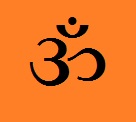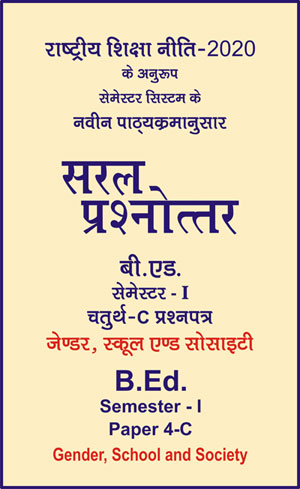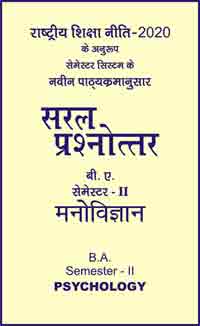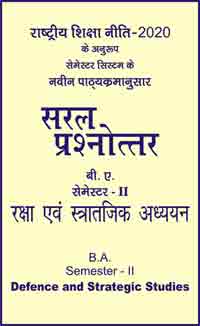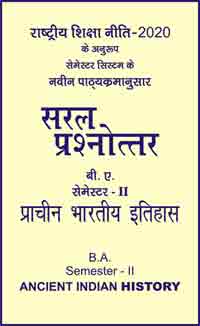|
बी एड - एम एड >> बी.एड. सेमेस्टर-1 प्रश्नपत्र-IV-C - जेण्डर, स्कूल एण्ड सोसाइटी बी.एड. सेमेस्टर-1 प्रश्नपत्र-IV-C - जेण्डर, स्कूल एण्ड सोसाइटीसरल प्रश्नोत्तर समूह
|
5 पाठक हैं |
||||||
बी.एड. सेमेस्टर-1 प्रश्नपत्र-IV-C - जेण्डर, स्कूल एण्ड सोसाइटी (अंग्रेजी भाषाा में)
Chapter 1 - Concept of Gender
Question- What do you understand by Gender (word)?
Related Short Answer Questions
- What type of composition is gender?
- Write the general meaning of gender.
- Write a note on :
(i) Role in society
(ii) Trans-gender
Answer -
It is easy to understand the concept of gender through various examples and scientific studies. It focuses on explaining the social structure of gender. Concepts of gender include differences between gender and gender, gender dynamics, gender needs, gender analysis, and the concepts of the debate between equality and equality. All these concepts are interconnected and intersect other structures of society including class, caste, community, education, economics, polity etc. The origin of gender lies in the society and culture itself.
Gender is not a biological category, but arises from the behaviour of individuals in society, so gender is understood as a social construct, whereas gender is the opposite category. Gender is a biological construct. Individuals are divided into male and female on the basis of their biological characteristics. For example, women have breasts, while men have beards.
Hilary M. Lips (2014) argues that in some cases gender and gender are intertwined. For example, in some cases the social acceptance of femininity is due to biological design. In other words, a woman conceives and gives birth to a child. It is a reproductive function that deals with the biological structure of the female body. Therefore, it is not always possible to separate gender and gender. Gender is multidimensional in its nature. One of its dimensions is gender identity or identity, which refers to one’s identity as a man or woman in an individual form. Another dimension is that of gender roles. It means that women and men perform their work or performance in a particular way, which is socially or culturally appropriate. The third dimension is that of gender orientation i.e., whether they are attracted to their own gender and/or are also attracted to another gender.
Gender is an evolving concept and is used to understand the different status of women and men in society. The purpose of taking a look at gender is not to separate women and men or create conflict between them. It draws one’s attention to issues that have led to unequal relations between women and men. At the same time, it allows addressing these issues with appropriate measures that help reduce inequality rather than make it permanent. The concepts of gender and gender roles help us to understand that gender roles arise from the interactions between individuals, communities and their environments. This concept suggests to us those masculine and feminine roles are not associated with ‘male and female’ having biological traits but are learned during the process of socialization.
Each society gradually transforms a man or woman into a man or a woman, with different characteristics, behaviours, patterns, roles, responsibilities, rights and gender identities of women and men psychologically and socially, or say that they are historically and culturally determined. This leads us to an important understanding that the concept of gender is socially constructed. The word gender has a different meaning from the word sex and the difference in meaning was proposed by Ann Oakley in 1970 through her works on women and domestic work. ‘Sex’ refers to the biological, anatomical and genetic differences found between men and women. In contrast, the term gender is related to the social and cultural roles of women and men.
Gender is used as a conceptual (ideological) category or class, it is related to a group of ideas related to a man or woman. Society, like our above-mentioned market place activities, differentiates between men and women and assigns different social roles to them, hence the roles that men and women take in society are different. For example, men would be the bread earners for the family and women were given the responsibility or role of nurturing. Men are related to the discharge of aggressive and influential roles such as head of a state or army. On the contrary, those roles are prescribed for women, which include taking care of children or caring for the sick, etc. It has been argued by some thinkers and researchers that different roles and statuses have been assigned to men and women in society because they are biologically different and hence it is natural and unchangeable. Once we recognize that only women can perform parenting and caring roles in society, we limit the roles women can play.
Simone De Beauvoir has argued in his book “The Second Sex” that “a woman is not born; she is made later”. She goes on to say that as previously believed, it is not that women were naturally created for child care and domestic work, but that women were held back because of upbringing or education, or social and They were left behind because of cultural requirements or because of the limited educational or employment opportunities available to them.
Transgender is a very broad term that refers to people who do not conform to culturally defined reciprocal gender roles associated with their biological gender (Lindsay, 2015 36). Historically, the term trans-sexual was used by psychiatrists to refer to a community that experiences this that their biological body does not match their own realization or their gender identity. Trans-sexual people are genetically male or female but believe that they are people of the other sex. They find themselves ‘trapped’ in a wrong body and therefore likely to undergo gender reassignment surgery to conform to their gender identity. Transgender is a more inclusive term. It describes people who have a specific way of expressing or describing their gender identities. The term “transgender” is used as a very broad term. The term is used for individuals whose gender identity or gender-expression does not conform to traditional expectations of masculinity or femininity (Sabatello 2011: 45). Therefore, the term transgender includes the physical/psychological aspects of trans-sexual identity and includes different gender orientations. “As Suzanne Stryker puts it, "transgender" refers to all identities or behaviours that are social. Formally constructed sexes/genders transcend boundaries, intersect these boundaries, or occur in some strange or unique form between these boundaries. (Sabatello 2011: 45). Transgender people perform specific social rites and functions in different cultures. In India, the community performs certain cultural roles and these people see themselves more often as women. Although Indian Gender roles of trans genders in culture are well defined and this also gives legitimacy to transgenders as people who perform rituals, yet transgenders in India are among the most marginalized communities. Transgenders are often harassed, ridiculed and do not have access to education or employment, due to policy interventions in India, people’s attitudes towards the transgender community are slowly changing and are being called education or civilized. Some changes are also visible with regard to their access to the works.
It is difficult to say exactly how gender is natural or natural and how it is socially constructed, because as soon as a child is born, the family and society begin to socialize the child as a boy or a girl.
|
|||||




